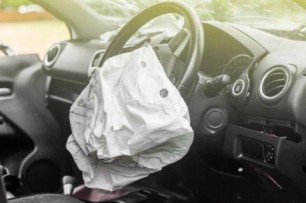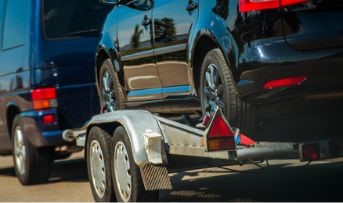General Insurance Blogs, Articles & Updates by - Magma HDI
Have us call you
- RENEW YOUR POLICY
- BUY NEW POLICY

Let's understand the importance of airbags in car and passenger safety
Safety technology is one of the most critical aspects to consider when purchasing a vehicle. For first-time buyers who want to know the importance of a vehicle's safety technology, it is a collection of intelligent technologies and devices built in the car to prevent collisions and ensure the safety of the passengers and the vehicle. Airbags are a common type of protective device present in all cars today.
Maintaining and abiding by all safety measures is essential to keep others and yourself safe. However, investing in trustworthy online car insurance can add an additional layer of protection to your vehicle.
With the car companies upgrading to the latest safety technologies, we must also understand their importance, especially airbags.
What are airbags?
Airbags are a type of supplemental restraint device (SRDs) whose main aim is to protect the individuals in the front seat from any injuries in case of a collision. When the car crashes, an electronic mechanism is triggered, and these airbags inflate with gas quickly. They are designed to instantly cushion and protect the driver upon impact and deflate soon after deployment. When airbags were introduced in 1951, most cars had this flexible fabric bag installed only to protect the driver. Today, most car models have it inbuilt for both the front occupants, the driver and the passenger. In 2021, the Central Government of India made passenger airbags mandatory for all vehicles to improve safety norms in the country.
Some car models only have airbags installed for the driver and the front-seat passenger. However, there are a few advanced models that have them installed in a way to protect the passengers in the back seat. While it is only mandatory to have airbags for the front passengers, cars that provide airbags for both back and front are the best to ensure maximum safety.
How effective are airbags?
Airbags are a crucial mechanism in your vehicle, and one cannot ignore their significance in improving the level of safety of your car.
An airbag comprises a thin nylon fabric bag, a set of inflators, and a sensor. It is designed to signal the inflators to blow up the nylon bags on detecting a collision. This mechanism goes a long way in avoiding severe facial, chest and head injuries.
While this device cannot stop or prevent a dangerous event like a road accident or car crash like other advanced safety technologies, it can protect the occupants from injuries and fatalities. The passengers are not only saved from the harsh impact of a collision but also avoid hitting any hard or sharp objects inside the car that can cause severe damage.
Several reports have confirmed that the rate of fatalities caused by dangerous accidents or collisions has significantly dropped, thanks to the safety devices including airbags. They can be most effective when the passengers are buckled-up and sit firmly in their seats.
To sum it up, drivers and passengers must always follow specific safety measures like wearing a seat belt, driving at a steady pace, adjusting the rearview and side mirrors for a clear vision, and not being distracted while driving. In addition to it, having a secure online car insurance can further cover the damages caused due to road accidents. So, before you purchase a new car, consider all safety technologies including the airbags for crucial cushioning for people during a crash.
Find the best car insurance India for your vehicle HERE .
Disclaimer: The information provided above is for illustrative purposes only. To get more details, please refer to policy wordings and prospectus before purchasing a policy.

Learn how you can deep clean your car's trunk
As the owner and user of your vehicle, you need to understand the importance of cleaning your car regularly to save money and ensure that your vehicle is safe and hygienic for other passengers.
The vehicle's trunk can become the dirtiest place due to the stuff we put there. It could be the dust from the roller bags and carry-ons, stains from the fruits and vegetables, baby items, liquids, and more. So, it is essential to deep clean the trunk of your car to keep the atmosphere in the vehicle healthy and avoid any smells, decaying, and dust that could be harmful to the health of the people sitting inside.
This blog will teach you how to deep clean your car’s trunk. Without any further delay, let us get started!
1. Identify the suitable materials:
For deep cleaning, you need to identify the suitable materials you must use to ensure that it does not cause any adverse effects like bad odour, staining the carpet or the rag in the trunk, damaging the surface inside the trunk, etc. Removing the stains and cleaning the trunk is essential, but the right kinds of detergents, liquids, and cleaning cloth helps you make the process easier and show effective results.
2. Remove the lint:
You often store your furry coats, jackets, sweaters, trench coats, etc., in the trunk. Such clothes generally leave particular woollen shreds called lint on the surface of the trunk, which should be removed properly. If not, they tend to stick to interiors and lose their colour when they come in contact with chemicals in cleaning liquids, soaps, or detergents causing irremovable stains.
3. Vacuuming efficiently:
Deep cleaning involves cleaning the surfaces, the trunk, and the carpet-rolled interiors. However, do not stop just at the cleaning but also vacuum the trunk to get rid of those tiny pieces of paper, leaves from the vegetable stems, or fruit peels. Clean everything that is not easily visible to the naked eye while cleaning. The trunk of your car can be a complex surface to maintain if you do not deep clean regularly and follow the complete routine and methods.
4. Cleaning the carpet:
While the surfaces are supposed to be clean, do not just leave the carpet and vacuum it regularly. Occasionally, remove the carpet from the trunk and wash it well by shampooing and conditioning it. You need to dry it completely before putting it back in the trunk. Even a slightly wet carpet can cause damage by giving rise to bacteria, thus making it unhealthy and unhygienic for you and the people in your car.
Adding to this list, remember to clean the lid of your trunk. A dirty top of the trunk of your car might make your entire effort of deep cleaning your car’s trunk go to waste due to the dirt and dust sitting on it.
We hope you found this blog valuable and effective in maintaining cleanliness and pleasing odour inside your car. Moreover, it is always a good idea to get car insurance and protect your vehicle from any damages which might be caused during unfortunate circumstances. Explore your options and purchase the best car insurance India that optimally caters to your needs.
Click HERE to learn more about car insurance India.
Disclaimer: The information provided above is for illustrative purposes only. To get more details, please refer to policy wordings and prospectus before purchasing a policy.

Make these essentials a part of your summer travel checklist
Summers are here, and by now, you've probably made plans to detach from the routine life and plan an exotic vacation for the perfect summer. Overworking may lead to fatigue, stress, and significant health hazards. Taking a break is highly demanded by your body to unwind all the stress and rejuvenate to get back to work with a new positivity.
Whether you're flying across the nation or going on a road trip for a few days, there are a few travel essentials you should pick up before leaving your home. In today’s topic, we bring a helpful checklist of travel essentials that are a must to carry while planning a holiday this summer.
1. Sunscreen:
The scorching heat of summers invites tanning and burns that adversely affect the body. You should apply sunscreen before heading outside in the harsh sun. A sunscreen with an SPF35 or plus will block out around 95% of Ultraviolet radiation, which causes sunburns and raises the risk of skin cancer.
2. Hat and Sunglasses:
A hat will provide some relief from the heat by avoiding the direct contact of your head with the sunrays. Although a hat will provide some shade, it's also crucial to protect your eyes and ensure you carry your sunglasses.
3. Backpack:
One of the most pleasing aspects of an active holiday is the possibility of discovery. Invest in a good backpack to enjoy it. It should be light and with a waistband to relieve back pressure. We advise that you choose a rainproof rucksack with many safe and secure compartments.
4. Water bottle:
Hydration is crucial, especially in summers. We recommend getting a bottle with water level marking on it so that you can keep track of the amount of water you consume in a day. Regular sipping of water will help you stay active and keep your body engaged.
5. Comfortable clothes:
Most summer vacations are spent at the beach or poolside. Carry your swimwear and comfortable beachwear.
6. Footwear:
Flip flops are ideal in summers. Along with your flip flops, also carry a pair of hiking shoes. They will help you when you set out on a hike.
7. Quick-drying towel:
It's helpful to have a quick-drying towel to avoid soaking other things in your suitcase on the way home.
8. Dry-wet bag:
Separating wet and dry stuff is useful when on a summer vacation at the beachside. A bag with two separate compartments will do the job for you.
9. First aid kit:
There is always a risk of scrapes, bruises, bug bites, and even an upset stomach. It's usually a good idea to keep a modest first aid kit with the essentials. This contains bug repellent, bandages, essential medicines, antiseptics, pain relievers etc.
10. General Insurance:
General Insurance should always be on your checklist no matter where you go. It will protect your travel, and you can enjoy the vacation with complete peace of mind. Invest in the best general insurance India and be rest assured of a safe and memorable trip.
The best part about any vacation is to forget the worries of everyday life and be in the moment at your favourite beach or mountain resort. Summer is probably the best time for family vacations, and with the restrictions getting eased out, the opportunities for planning trips will increase.
Also, don’t forget to carry your masks and hand sanitizers wherever you go because the pandemic has not ended yet. Take all the necessary precautions and make the above essentials a part of your travel checklist to set off on an exciting, adventurous summer holiday.
Visit HERE to explore plans of general insurance India.
Disclaimer: The information provided above is for illustrative purposes only. To get more details, please refer to policy wordings and prospectus before purchasing a policy.

What you need to know before getting your booster shot
India faced the third wave of the COVID-19 pandemic in January 2022. During these two years of resilience, we have controlled the spread of the virus with effective public health protocols. National and state lockdowns, social distancing, and mandatory face masks have contained the infection rate. Last year, introducing the various COVID-19 vaccines tremendously helped build strong immunity against the deadly virus.
Vaccination against the COVID-19 virus has proved to be an essential tool in helping effectively manage the pandemic. Fully vaccinated people are relatively well-protected against a severe coronavirus infection, complications, and mortality. However, even effective vaccines become less viable over time. Intensive research suggests that vaccinations lose some of their power over time. It has been found that eventually receiving another vaccine shot after a few months can help highly boost the vaccine's effectiveness. This additional shot is called the booster shot.
Receiving both vaccine doses is the first and foremost integral step to building a strong enough immunity to control the infection rate. While the vaccines are deemed safe and effective, and everyone has been advised to get the jab at the earliest, several members of the Indian population have still not been vaccinated. Before considering the booster shot, the goal is to vaccinate the country's entire population to build herd immunity.
Here is some information to know before getting your booster shot:
1. The booster doses have been rolled out from Jan 10th, 2022. They will initially be administered to the front-line workers and adults aged 60 and above with comorbidities.
2. The booster is given 9 months or 39 weeks after administering the second dose of COVID Vaccine as per the guidelines.
3. The vaccine's side effects are reportedly similar to the previous doses, including fever, body and muscle pains, headache, pain, or swelling at the injection site.
4. Unlike other countries, Indians are advised to get the booster from the company as their previous vaccine doses and not mix any other. Citizens who have taken two shots of Covishield must take the Covishield booster shot only, and those who have taken Covaxin should go for the Covaxin booster shot. Do not take the alternate vaccine as it might create a complication.
5. The first two doses of the COVID-19 vaccine boost our body's immune system. With these shots, memory cells that remember the virus are produced to help in case of an infection. The number of these cells increases with the second dose and helps fight the infection.
When these memory cells are challenged with a booster, they induce a robust immune response. As a result, the booster shot produces more antibodies that have an increased potency to fight the virus.
While taking the vaccines is integral to stay safe from the virus, one must remain vigilant and follow the safety protocol. Vaccination alone is not enough to fight the pandemic and the constantly emerging variants. In these challenging times, prioritising health is paramount. Remember to renew health insurance online or simply contact your insurance company to ensure your safe future.
Apart from maintaining your health insurance, you must indulge in healthy activities like yoga and vigorously consume a nourishing diet to combat any health ailment or infection.
Click HERE to renew health insurance online.
Disclaimer: The information provided above is for illustrative purposes only. To get more details, please refer to policy wordings and prospectus before purchasing a policy.

What does the budget 2023 have for the insurance sector
The Government of India presented the union budget on 1st February 2023. It has provided incentives for the people to move from the old tax regime consisting of deductions and rebates to the new tax regime. This, in turn, will affect the insurance sector as well.
While there were a few surprises here and there, it has proposed a significant change by taxing maturity proceeds of insurance policies commanding an aggregate premium of over Rs.5 lakhs in a financial year. Such high premiums usually occur in the case of money-back insurance plans that require one-time premium payments or endowment plans.
Here are some of the key recommendations that would impact life insurance sector.
1. No change in Section 80C and 80D:
Insurance premium amounts paid for insuring the life of self, spouse, or child are presently eligible for deduction under Section 80C of the Income Tax Act up to Rs.1.5 lakhs per annum. This is irrespective of whether our child is minor or major, dependent or independent. Also, individuals, as well as Hindu Undivided Family (HUF), are both eligible for claiming this deduction.
Similarly, Section 80D allows a person to claim a deduction for health insurance premiums and expenses incurred towards preventive health check-ups for self, spouse, children, and even parents up to Rs.65000/- per annum, subject to certain conditions.
The budget of 2023 could have been better for the insurance sector of the limits under Sections 80C and 80D. The industry expected a raise in the limits under these sections to boost consumer savings and investment. However, these limits have been left untouched in the budget of 2023.
2. The choice between the old-tax regime and the new-tax regime:
Till now, there was an option to choose between the old-tax regime that allows for several deductions and rebates and the new tax regime that taxes your income at a flat rate. You could choose either of the two and enjoy the above deductions under Sections 80C and 80D by choosing the old-tax regime.
There has been a shift in policy in this regard in the budget of 2023. The new tax regime is the default setting for individuals, under which you cannot enjoy these rebates. If you still want to enjoy deductions under Sections 80C and 80D, you will have to choose the old-tax regime specifically.
3. Aggregate premium clause:
According to the budget of 2023, if the aggregate premium paid by an individual is over Rs.5 lakhs in a financial year starting 1st April 2023, he will have to pay tax on their maturity proceeds. However, if such a policyholder dies, the nominee's maturity proceeds will be tax-free.
Maturity proceeds or income from insurance policies having an aggregate premium of less than Rs.5 lakhs in a financial year will be exempted from taxation. However, the introduction of this clause may discourage consumers such as High-Net-worth individuals (HNIs) from buying big-ticket insurance products to save taxes. As a result, the revenues or top-line of the insurance companies are bound to suffer and go down.
The Insurance industry plays a vital role in the overall financial growth of the country, and as such, the sector is undoubtedly not very encouraged with the budget for 2023. There was a general expectation of an extension of the Rs.1.5 lakhs deductions allowed under Sections 80C and 80D, which still needs to be met. Moreover, taxing the maturity proceeds of policies commanding an aggregate premium of Rs.5 lakhs or more in a financial year will further dampen the sales of high-value insurance policies.
However, insurance buyers need not be worried as the prevalent deduction limit is still the same and has not gone down. Also, a very small percentage of Indians buy high-value insurance policies, and the changed clause is unlikely to affect most Indian residents. Online general insurance policies continue to offer the same ease, protection, and security, and individuals can continue to enjoy its benefits.
Click HERE to buy online general insurance plan to safeguard your valuable assets.
Disclaimer: The information provided above is for illustrative purposes only. To get more details, please refer to policy wordings and prospectus before purchasing a policy.

Importing a car to India? Here is a list of things to consider
Indian celebrities, cricket players, and business tycoons have all made headlines for driving fancy foreign cars that they brought into India. It takes time and is complicated to import a foreign car into India. But if someone is willing to put in the time and money, they can import their dream car by following the rules and going through the process.
In this article, we'll go through the steps involved in bringing a foreign car into India and some crucial rules you must abide by.
India has stricter regulations than other nations regarding the import of foreign cars. Foreign cars will be permitted to drive on Indian roads only if they meet all requirements.
Guidelines for importing a new car.
To import a new car, the following prerequisites must be satisfied:
● The car must be built or assembled outside of India.
● The car must be brand new in every way, and you can only import it from the nation where it was made. It cannot have been registered, leased, sold, or loaned before being imported into India.
● A right-hand driver's car is required.
● Kilometres, not miles, should be displayed on the speedometer.
● You can use only the naval docks in Mumbai, Chennai, and Kolkata to import cars. Therefore, you should use just one of these ports to transport the car to India.
Rules for importing a used car.
The procedures for importing a used car into India are complex and may take longer than expected. The rules are as follows:
● Imported used cars shouldn't have a manufacturing date older than three years.
● It must be a right-hand drive car.
● Kilometres, not miles, should be displayed on the speedometer.
● Again, only naval docks in Mumbai, Chennai, and Kolkata are allowed to transport the car to India.
● The car should be financed, leased, registered, or sold.
● It must have a roadworthiness certificate with a minimum 5-year validity.
Who is authorised to bring commercial cars into India?
You must meet additional requirements before you can import commercial cars into India. Because people can travel in passenger cars, SUVs, and jeeps that were imported, the rules for commercial cars are strict. The following are the profiles that can bring such cars into the country:
1. An NRI who last lived in India at least two years before the import and owned a car for at least a year.
2. Relatives, i.e., the legitimate heirs or successors of a person who passed away overseas and left a car in their care.
3. Individuals with physical disabilities.
4. Companies with foreign equity participation that are already operating in India.
5. International corporations with a presence in India.
6. Trusts that are legally established for religious, missionary, or charitable purposes in India and abide by the regulations established by the state or central government.
7. Any honorary consuls that the Indian government's Ministry of External Affairs recommends.
8. Any journalist who possesses an accreditation certificate issued by the Bureau of the Indian government's Ministry of Information and Broadcasting.
Things to take into account before bringing a car into India.
Before you start the time-consuming process of bringing a car into India, you need to think about a few essential things.
1. Import taxes on cars:
You might be required to pay an import duty of up to 116% of the car's CIF (cost, insurance, and freight) value.
2. Registration:
The closest RTO in India must register the car. The import tariff does not include the fees for registration and road tax. These fees vary based on the kind and price of the car.
Insurance is essential to drive your car in India legally. You can conveniently buy car insurance online to financially protect you from paying for damages caused by an accident or third-party liabilities. Your car insurance can offer financial security against collision, fire, or other unavoidable natural or man-made disasters.
Click HERE to buy car insurance online.
Disclaimer: The information provided above is for illustrative purposes only. To get more details, please refer to policy wordings and prospectus before purchasing a policy.

How to raise a 2 wheeler insurance claim without an RC or licence
The Driving Licence (DL) and Registration Certificate (RC) are two crucial documents for any vehicle in the country. Without this, your vehicle is not registered under the law. It also means that you are not eligible to be a legal driver of your concerned vehicle.
When filing an insurance claim, you need to produce these two documents before your insurance company. They are crucial in determining your ownership details. However, many circumstances result in the loss of these documents. What will you do then? Will you lose the 2 wheeler insurance claim?
If you're looking for the answers to the questions above, this article is definitely for you.
What is an add-on for 2 wheeler insurance?
Many unforeseen circumstances can cause the theft, loss, or damage of your driver's licence and registration certificate. Although this nullifies your vehicle ownership under the law, certain factors can help you.
In situations like these, the Registration Certificate add-on or Loss of Licence comes to your rescue. It is an additional cover for your 2 wheeler insurance. Under this, you need to pay a higher interest rate or premium. The add-on ensures that you experience additional benefits as the owner of your vehicle and insurance.
You can easily buy the add-on when applying for your 2 wheeler insurance. It can be done both online and offline without any hassles. This add-on is extremely helpful in situations when you lose your Driving License or Registration Certificate. It ensures that you still get your insurance claim.
Benefits of add-on:
● It enables you to apply for an insurance claim without a driver's licence or RC
● You are entitled to receive monetary support in case your driving licence and registration certificate are lost or stolen
● It will serve as a helper when the claim is settled
● The add-on comes with a very partial increase in the insurance premium
What to do when DL or RC is lost or stolen?
If your Driver's Licence or Registration Certificate is stolen or lost, you need to do the following things immediately:
● Go to the police station and file a complaint about the theft
● Make sure to get a copy of the FIR with you
● Go to the nearest RTO office and file for a duplicate copy of your DL or RC. Attach the photocopy of the FIR along with the required documents
● Pay the given fees
● For a DL, you need to complete the biometric process as well
● The documents will be safely delivered to your address
What to do while filling an insurance claim without a DL or RC?
If you're filing an insurance claim for your 2 wheeler insurance, then you should:
● Make sure that you apply for the claim within the specified time
● Fill out the form with the correct information. Check it twice
● Gather all the required document
● Initiate the claim
● You should provide all the proofs if you have lost your DL and Registration Certificate. If you have an add-on, this process is all the easier
● Before applying for the claim, read all the terms and conditions carefully
These are the simple yet effective things you should remember while filling a 2 wheeler insurance claim if you misplace your licence and RC. However, always ensure that you keep all your important documents in the right place and prevent them from being lost or stolen. This can cause you great distress otherwise.
Click HERE to buy the best 2 wheeler insurance.
Disclaimer: The information provided above is for illustrative purposes only. To get more details, please refer to policy wordings and prospectus before purchasing a policy.

Explore these five popular street food tours in India
Several factors need to be considered while finalising your holiday destination. You need to think about the budget, hotels, amenities, safety, etc. But one of the essential elements which determine your vacation destination is food.
Street food has a huge fandom. People of all ages love the culture of street food and local cuisine. You not only get varieties of food, but street food is quite pocket-friendly and on-the-go. If you are a food enthusiast, then different street food tours in our country will give you an unforgettable gastronomic experience.
In this blog, we will be discussing five popular street food tours in India.
1. Street food crawl in Varanasi:
A food tasting tour of Varanasi's old town helps you explore the food culture, which still hints at the ancient palette of the city's long history. A part of this walking, street food tour is visiting the oldest shop in Kashi and seeing how the most famous delicacies are prepared and tasting them after a quick demonstration.
2. Food and Heritage walk in Old Delhi:
While New Delhi has seen fast-paced growth and development and is still advancing with time, Old Delhi holds the culture together and keeps it alive. It brings the generations together with heritage and food.
Mixing heritage walk with food in Old Delhi immerse you in the places from cultural depths and taste the local cuisines that carry the original flavours from the legacies of the Mughal Dynasty. Old Delhi is a tasty retreat especially for non-veg lovers to enjoy a few unique and mouth-watering delicacies at every stall.
3. The food lanes of Kolkata:
A food tour in Kolkata begins with a bit of street vendors and leads to exploring one spot followed by another. During your time in Kolkata, you will get to taste jumbo prawns in coconut milk curry, onion bhajis, a range of chicken curries, and different varieties of authentic Bengali sweets like rasgulla and cham-cham that will melt your heart.
The tour has the perfect ending- coffee at one of the oldest colonial coffee houses in Kolkata. You can explore many Bengali delicacies and drinks during your exploration of Kolkata food streets.
4. Explore Jaipur food trail:
A food tour of Jaipur offers you the experience of the culture of Jaipur through its food palette. In just a few hours during your trip around Hawa Mahal, you can taste the famous and authentic delicacies of Jaipur. You will get the opportunity to explore the traditional and historical places, eat Rajasthani dishes and shop in the street markets.
5. Eat where locals go in Old Mumbai:
This food adventure in Mumbai gets you to explore three different districts that offer distinct delicacies like curries with crispy papads, Chowpatty's chaat, snacks, kebabs, hand-churned ice creams, and much more. All this food paired with stories about the vibrant Old Bombay will make your visit a memorable one.
After the delicious discussion about these popular street food tours in India, you also need to understand the importance of your safety during the trip. These tours will take you through crowded streets and congested spaces. It would be wise to explore different insurance plans of the best general insurance company to ensure the safety of you and your belongings while travelling.
Click HERE to know more about the general insurance company and the plans that you can invest into.
Disclaimer: The information provided above is for illustrative purposes only. To get more details, please refer to policy wordings and prospectus before purchasing a policy.


